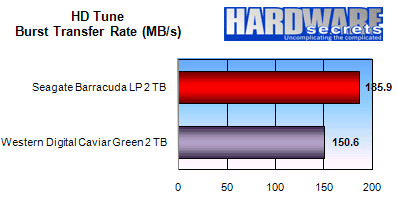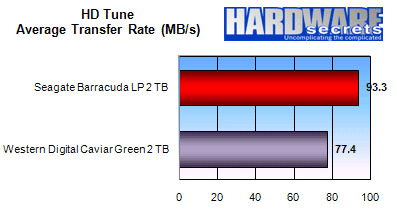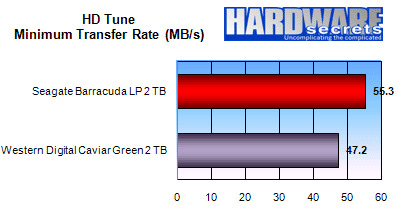[nextpage title=”Introduction”]
So far only two 2 TB hard disk drives have reached the market and both are “green” models, meaning they rotate at lower speeds in order to save energy. Models spinning at 7,200 rpm will reach the market only by the end of the year (it is more complicated to build a 7,200 rpm 2 TB drive than a 5,400 rpm one) and they will be faster than these two models we are reviewing today. Let’s compare the performance of Seagate Barracuda LP with Western Digital Caviar Green.
Seagate Barracuda LP spins at 5,900 rpm, while Western Digital does not disclosure the rotational speed from Caviar Green (5,400 rpm is our educated guess). Hard drives typically consume between 8-10 W; “green” models like the two we are going to compare consume practically half of this.
Both 2 TB models we tested have a real capacity of 1.82 TB or 1,863 GB (3,907,029,168 sectors). As you may be aware, the capacity advertised by hard disk drive manufacturers isn’t the real drive capacity. Read our Hard Disk Drives Capacity Limits tutorial for further information on this subject.
Here is a summary of the two hard drives we are going to compare:
| Manufacturer | Model | Model # | Buffer | Price |
| Seagate | Barracuda LP | ST32000542AS | 32 MB | USD 239.99 |
| Western Digital | Caviar Green | WD20EADS | 32 MB | USD 239.99 |
Prices were reasearched at Newegg.com on the day we published this review.
Now let’s see which drive is the fastest 2 TB product.
[nextpage title=”How We Tested”]
During our tests we used the configuration listed below and the only variable component between each benchmarking session was the hard disk drive being tested.
Hardware Configuration
- CPU: Core 2 Duo E6600
- Motherboard: ASUS P5K-E/WiFi-AP (1013 BIOS)
- Memory: 2 GB Corsair Dominator TWIN2X2048-8500C5D (DDR2-1066/PC2-8500 with 5-5-5-15 timings), configured at 1,066 MHz
- Video Card: Gigabyte GeForce 8800 GTS 320 MB
- Video resolution: 1440×900 75 Hz
- Video Monitor: Samsung Syncmaster 932BW
- Power Supply: OCZ ProXStream 1000 W
- CPU Cooler: Thermaltake TMG i1
- Optical Drive: LG GSA-H54N
Software Configuration
- Windows XP Professional using NTFS file system
- Service Pack 3
- Intel Inf driver version: 9.0.0.1008
- NVIDIA video driver version: 175.19
Benchmarking Software
We adopted a 3% error margin. So, performance differences below 3% cannot be considered meaningful. In other words, products where the performance difference is below 3% must be considered as having similar performance.
[nextpage title=”HD Tach”]
Usually we use three programs to evaluate hard disk drive performance, DiskSpeed32, HD Tach and HD Tune. DiskSpeed32, however, would freeze exactly in the middle of the data gathering process and our best guess is that this program isn’t compatible with 2 TB drives. Thus unfortunately we had to keep it out of our benchmarking process.
HD Tach provides only two results, the burst transfer rate and the average transfer rate. We ran the “long bench” test from this program.
On the burst transfer rate measured by HD Tach Western Digital Caviar Green 2 TB was 6% faster than Seagate Barracuda LP 2 TB. Keep in mind that the burst transfer rate measures the maximum transfer rate between the motherboard SATA port and the hard disk drive controller located on the drive itself, and may not represent real-world performance.
Average transfer is certainly the most important parameter for the regular PC user and on HD Tach Seagate Barracuda LP 2 TB was 20% faster than Western Digital Caviar Green 2 TB.
[nextpage title=”HD Tach: Read Curves”]
If you are interested, you can find below the read curves plotted by HD Tach for the two hard disk drives tested.
Seagate Barracuda LP 2 TBWestern Digital Caviar Green 2 TB
[nextpage title=”HD Tune”]
Now we have the results provided by HD Tune.

Here Seagate Barracuda LP 2 TB was 23% faster than Western Digital Caviar Green 2 TB. Keep in mind that the burst transfer rate measures the maximum transfer rate between the motherboard SATA port and the hard disk drive controller located on the drive itself, and may not represent real-world performance.

The most important figure for most people is the average transfer rate. Here Seagate Barracuda LP 2 TB was 21% faster than Western Digital Caviar Green 2 TB.

The maximum transfer rate is achieved when the hard drive is reading data from its outer-most tracks.
Here Seagate Barracuda LP 2 TB was 25% faster than Western Digital Caviar Green 2 TB.

The minimum transfer rate is achieved when the hard drive is reading data from its inner-most tracks.
Here Seagate Barracuda LP 2 TB was 17% faster than Western Digital Caviar Green 2 TB.
[nextpage title=”HD Tune: Read Curves”]
If you are interested, you can find below the read curves plotted by HD Tune for the two hard disk drives tested.
Seagate Barracuda LP 2 TBWestern Digital Caviar Green 2 TB
[nextpage title=”Access Time”]
Access time is another important measurement. It measures the time the hard disk drive delays to start delivering data after the computer has asked a given data. It is measured in the order of milliseconds (ms, which is equal to 0.001 s) and the lower this value, the better.
The results presented by the two programs were slightly different, so this time we plotted a chart showing the two programs.
In both programs Seagate Barracuda LP 2 TB achieved a better performance. On HD Tach it presented an access time 18% lower than Western Digital Caviar Green 2 TB, while on HD Tune it presented an access time 14% lower than its competitor.
[nextpage title=”Conclusions”]
It is crystal clear that the fastest 2 TB hard disk drive available today is Barracuda LP from Seagate, which is 20% faster than its main competitor, Western Digital Caviar Green. Of course this scenario will change when 7,200 rpm products arrive on the market by the end of the year.
Price- and performance-wise today it only makes sense buying 2 TB units if you really don’t have enough bays to install several 1 TB drives. Not only 1 TB drives are cheaper (it is cheaper to buy two 1 TB drives than a single 2 TB unit), they are also faster, plus you can install two 1 TB drives in RAID0 in order to increase performance even more.








Leave a Reply